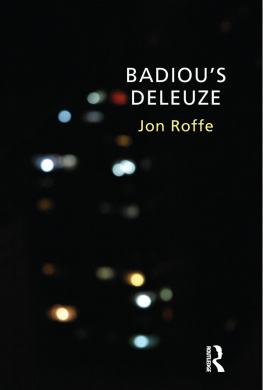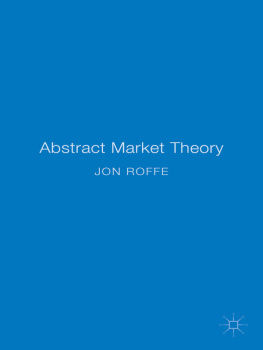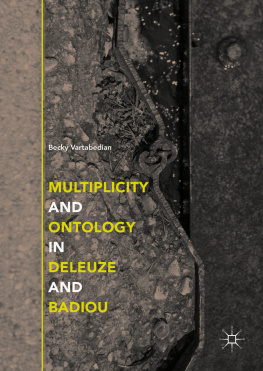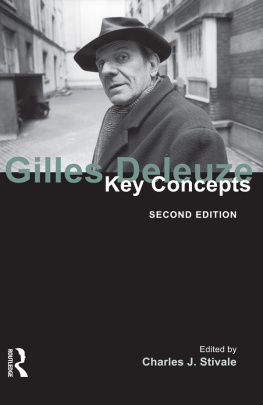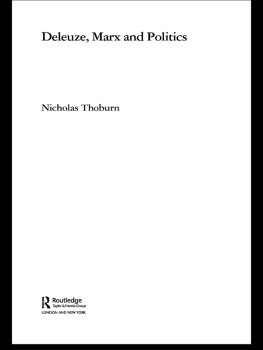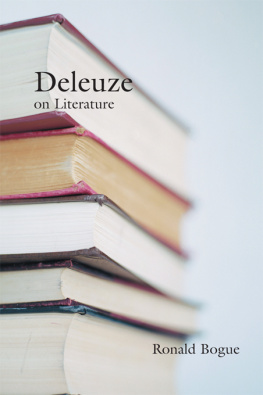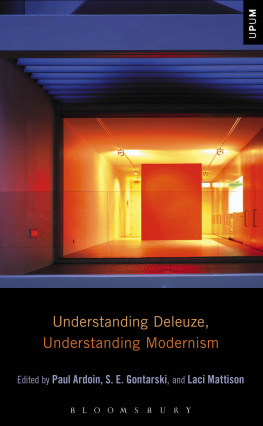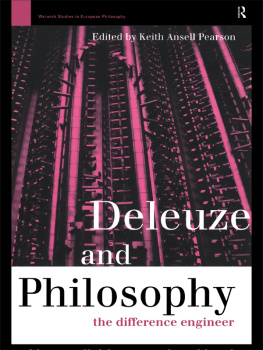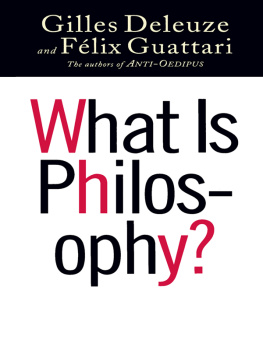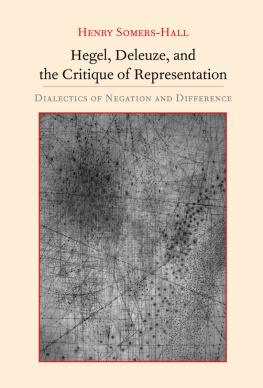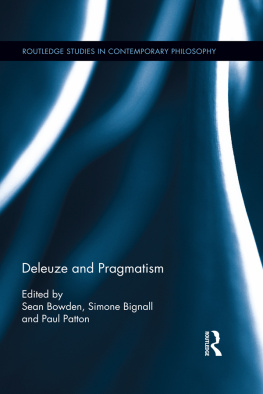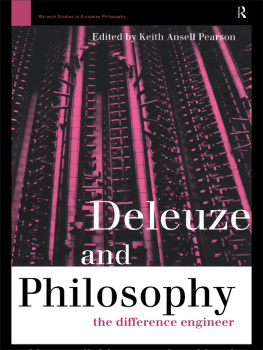BADIOUS DELEUZE
First published in 2012 by Acumen
Published 2014 by Routledge
2 Park Square, Milton Park, Abingdon, Oxon OX14 4RN
711 Third Avenue, New York, NY 10017, USA
Routledge is an imprint of the Taylor & Francis Group, an informa business
2012 Jon Roffe
This book is copyright under the Berne Convention.
No reproduction without permission.
All rights reserved. No part of this book may be reprinted or reproduced or utilised in any form or by any electronic, mechanical, or other means, now known or hereafter invented, including photocopying and recording, or in any information storage or retrieval system, without permission in writing from the publishers.
Notices
Practitioners and researchers must always rely on their own experience and knowledge in evaluating and using any information, methods, compounds, or experiments described herein. In using such information or methods they should be mindful of their own safety and the safety of others, including parties for whom they have a professional responsibility.
To the fullest extent of the law, neither the Publisher nor the authors, contributors, or editors, assume any liability for any injury and/or damage to persons or property as a matter of products liability, negligence or otherwise, or from any use or operation of any methods, products, instructions, or ideas contained in the material herein.
ISBN: 978-1-84465-508-3 (hardcover)
ISBN: 978-1-84465-509-0 (paperback)
British Library Cataloguing-in-Publication Data
A catalogue record for this book is available
from the British Library.
Lhistoire des hommes est la longue succession des synonymes
dun mme vocable. Y contredire est un devoir. Ren Char
CONTENTS
The following abbreviations are used throughout. Where two page numbers are listed, they refer to the English and French, respectively; any deviation from the published translation will be noted by the appendage of tm Where no English translation is referred to, the translations from the French are my own. In addition, references to Spinozas Ethics will follow the standard usage of indicating book, proposition followed by any required specification. Likewise, reference to Kants Critique of Pure Reason will be made to the respective pagination of the A and B editions.
TEXTS BY DELEUZE
| AO | Anti-Oedipus |
| B | Bergsonism |
| DR | Difference and Repetition |
| DRF | Deux Rgimes de Fous: Textes et entretiens 197595 |
| EPS | Expressionism in Philosophy: Spinoza |
| ES | Empiricism and Subjectivity |
| F | Foucault |
| FLB | The Fold: Leibniz and the Baroque |
| KCP | Kants Critical Philosophy |
| LS | The Logic of Sense |
| ID | Lle Dserte et Autres Textes |
| M | Masochism |
| MI | Cinema 1: The Movement Image |
| N | Negotiations |
| NP | Nietzsche and Philosophy |
| PS | Proust and Signs |
| TI | Cinema 2: The Time Image |
| TP | A Thousand Plateaus |
| WP | What is Philosophy? |
TEXTS BY BADIOU
| BE | Being and Event |
| CM | The Concept of Model |
| CT | Court Trait dOntologie Transitoire |
| DCB | Deleuze: The Clamor of Being |
| DVO | Of Life as a Name of Being, or, Deleuzes Vitalist Ontology |
| LM | Logics of Worlds |
| NN | Number and Numbers |
| TS | Theory of the Subject |
| TW | Theoretical Writings |
Over what were to be the final years of his life, Gilles Deleuze engaged in a long written correspondence with Alain Badiou. Badiou, in the light of his magnum opus Being and Event (Ltre et lvnement), published in 1988, had come to see Deleuzes philosophical project as the closest among those of his contemporaries to his own, and in turn saw Deleuze as his key rival in the attempt to present a philosophy of multiplicity and immanent being. This correspondence, unfortunately never published owing to Deleuzes dissatisfaction with its abstract tone (DCB 6/14), concluded at the end of 1994, shortly before the latters death. In 1997, Badiou published Deleuze: The Clamor of Being (Deleuze: Le clameur de Ltre), which was a final letter to Deleuze, a summary of their epistolary disagreements and a restatement of the critical appraisal of Deleuzes thought first expressed directly to Deleuze himself.
The Clamor of Being is presented as a work of demystification, an attempt to reinstate a classical image of the latters philosophy in the face of a pervasive attempt to cast him as a thinker of the heterogeneous multiplicity of desires (DCB 8/17): in place of the caricature, A faithful portrait of the master (DCB xii). The central claim of this work is infamous: that Deleuze, far from being a philosopher dedicated to propounding the fundamental status of multiplicity and difference, is rather concerned with the ultimate status of ontological unity: Deleuzes fundamental problem is most certainly not to liberate the multiple but to submit thinking to a renewed concept of the One (DCB 10/19). Ranging across a number of Deleuzes works above all his two key monographs from the late 1960s, Difference and Repetition and The Logic of Sense Badiou presents a surprising and, for some, shocking account of a philosopher who was often thought to be already understood.
Badious portrait of Deleuze was (and remains) particularly confronting for many who considered themselves partisans of his thought. The response of Arnauld Villani, who declared that this is a false book, the falsest book imaginable, is characteristic: in the place of the most beautiful movement of life, [Badiou] has only proposed an abstract field, he only manages to strike up a dirge (1998). And, while Villani himself, along with many others, sided with Deleuze, yet others again manned the barricades on behalf of Badiou. The Clamor of Being thus became the epicentre of conflict in thought.
The epistolary sequence concluded by The Clamor of Being is rooted in an engagement with Deleuzes thought that begins much earlier. Its first incarnation is entirely polemical in nature, and is manifested in Thorie de la contradiction, published in 1975, and two texts from 1976, all of which directly attack the aspect of Deleuzes philosophy that Badiou will later declare to be inessential, namely, the account of desire and multiplicity found in that grimoire, Anti-Oedipus (1972) and the text Rhizomes (1976), which would later take the form of the infamous first chapter of A Thousand Plateaus (1980).
Thorie de la contradiction, a thoroughly Maoist presentation of contradiction and the dialectic, adds saint Gilles (Deleuze), saint Flix (Guattari) and saint Jean-Frangois (Lyotard) to Marxs Saint Max (Stirner). For Badiou, their philosophies, committed as they are to propulsive desire, evasive flux, to the heterogeneous, and to the critique of all organization and totalitarian Marxist-1 eninism, merely repeat word for word the kind of claims that Marx and Engels German Ideology needed to tear to pieces in order to present a cogent revolutionary program (Badiou 1975: 61).
Next page
